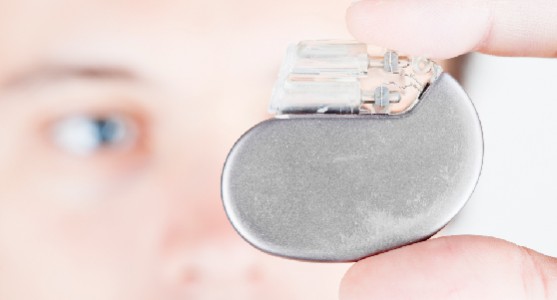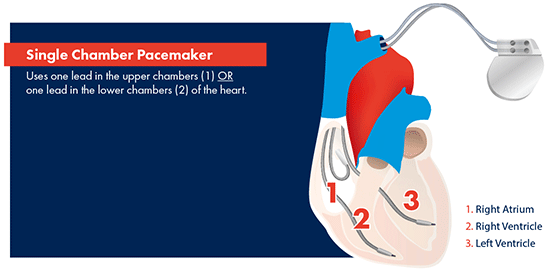Setting the pace for medical advancements
Author:
![]() Helen Croft, Underwriting and Claims Strategy Manager
Helen Croft, Underwriting and Claims Strategy Manager
Wednesday 22 August 2018
They are the size of a matchbox, have been around for over 50 years and saves the lives of 25,000 people a year.
They may look innocuous but pacemakers have revolutionised the treatment of dysrhythmias and abnormal heart rates, designed to drive the heart when its natural pacemaker mechanism fails.
Traditionally consisting of a box with a battery and computerised device, and a choice of one, two or three leads. The box is implanted under the skin just below either shoulder, usually on the left hand side, and the leads deliver electrical impulses to stimulate the heart to contract and produce a heartbeat.
Each pacemaker is programmed to the person it is fitted to and is designed to work on demand, responding to the needs of the patient. Most pacemakers have a special sensor that recognises body movement or your breathing rate.
It’s essentially there as your very own safety net - silently monitoring your heart rate and stepping up when it detects any irregularities. If the pacemaker senses that your heart has missed a beat or is beating too slowly, it sends signals to reset the pace back to normal.
There are 3 different kinds of pacemaker that can be administered:

Why are they needed?
The heart is a pump made of muscle, controlled by electrical signals. These signals can become disrupted for several reasons, which can lead to a number of potentially dangerous heart conditions, such as:
- an abnormally slow heartbeat (bradycardia)
- an abnormally fast heartbeat (tachycardia)
- heart block – where your heart beats irregularly because the electrical signals that control your heartbeat aren't transmitted properly
- cardiac arrest – when a problem with the heart's electrical signals cause the heart to stop beating altogether
For such a small procedure, the impact can be huge. Heart rhythm disturbance tends to cause things like chest pain and shortness of breath. So a well chosen pacemaker that’s fitted correctly can instantly alleviate these symptoms.
Most pacemakers store information about your natural heart rhythms. When you have follow-up appointments, your doctor can retrieve this information and use it to check how well your heart and the pacemaker are working.
Leadless pacemakers
Medical science is fast-paced and despite the success of the traditional pacemaker, the design was refreshed in 2014, creating a wireless device no bigger than a pill, which is administered without the need for surgery.
The new device uses wireless technology and can be implanted directly into the heart, where it delivers electrical impulses from an electrode. This means a lead isn't required, which has the benefits of lowering the risk of infection and shortening the recovery time associated with implanting traditional pacemakers.
At AIG, we are committed to keep moving with the times and making sure the cover we provide reflects what is happening in today’s world. This is why we have included permanent pacemaker insertion into our new Critical Illness proposition – providing a partial payment of up to 50% or £35,000.
Pacemakers are the perfect example of the achievements of modern medicine and we are looking forward to seeing how these small but powerful little boxes continue to be developed and save even more lives in the process.
To highlight this further, hear from Chief Medical Officer, Dr. Rob Rosa who provides a first-hand insight into how important these devices really are.
Rob-Rosa-Pacemaker
Rob Rosa Pacemakers and Critical illness cover on Vimeo.
Rob-Rosa-Pacemaker
Pacemakers have actually revolutionised our treatment of dysrhythmias and abnormal heart rates in medicine. As the years have progressed we've actually gone now to quite incredible devices. Now, these pacemakers are really novel agents; they will either correct an abnormal rhythm, slow up a very fast rhythm or speed up a very slow rhythm. So we can actually programme them manually in order to keep somebody at a nice regular distinct rhythm permanently. The way in which we actually fit them is you make a very small incision just under the skin, create a little pocket; it's usually just on the left-hand side. The pacemaker itself is a little disc. That sits inside there. This is all done as a day case unit, taking perhaps no more than 30-to-60 minutes in the operating theatre.
They have a couple of leads; they will attach inside the heart, sit inside the chambers and bury themselves into the wall. What they do is they keep that nice regular rhythm, so it's designed to kick in when your rhythm goes into an abnormal one. The follow-up checks take place every six-to-12 months. The batteries last a few years. Really once it's in place, life doesn't really change at all. In fact most people should feel slightly better. Heart rhythm disturbance tends to cause things like chest pain or even some aching and certainly some shortness of breath. So actually a well-chosen pacemaker that's fitted correctly and is working properly actually makes you feel an awful lot better. So in terms of the procedure itself, pretty slick, very quick, very simple technically. In terms of the long-term prognosis; absolutely excellent. In terms of you feeling better; once you've had it inserted, you feel brighter, you're able to walk further with less shortness of breath and your limitations on life, apart from extreme strenuous exercise, actually sees no difference whatsoever.
[END OF TRANSCRIPT]
1https://www.bhf.org.uk/informationsupport/heart-matters-magazine/medical/pacemakers
2https://www.nhs.uk/conditions/pacemaker-implantation/
3https://www.bhf.org.uk/for-professionals/press-centre/facts-and-figures